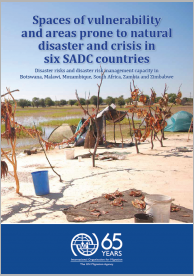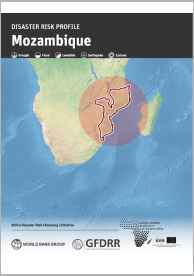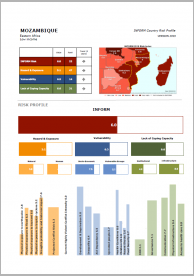Cyclones are the most significant and common natural hazard in Mozambique. Droughts, floods, landslides and earthquakes also affect the country (WB, 2016). In order to address these challenges, the government has been promoting the implementation of several disaster management measures (UNISDR, 2019).
The main governmental body responsible for overseeing DRR operations in the country is the National Institute for Disasters Management (INGC – Instituto Nacional de Gestão de Calamidades – in Portuguese). In addition, there are other institutions with responsibilities in this field, namely the Disaster Management Technical Council and the Disaster Management Coordinating Council.
Mozambique has a strong disaster risk management and reduction framework. The main legal and guiding instruments are the National Policy on Disaster Management (1999); Act no. 15/2014 - Disaster Management Act (2014); and the Master Plan for Disasters Prevention and Mitigation 2017-2030.
Despite Mozambique's achievements in this field, the country still faces some challenges, particularly in what concerns data collection and institutional coordination mechanisms at district levels. Nevertheless, Mozambique has recently reaffirmed a strong commitment to accelerate Sendai Framework implementation (UNISDR, 2019).
- UNISDR (2019). Global Platform for Disaster Risk Reduction - Speeches and Statements. Retrieved from https://www.unisdr.org/conference/2019/globalplatform/programme/offic…
- WB (2016). Disaster Risk Profile. Washington: World Bank.
In Mozambique, a country located in south-east Africa, very extended in latitude, the climate is tropical, with a hot and rainy season from November to March, and a dry season from May to October, during which there is a cooler period from mid-May to mid-August. In inland areas, especially in the north-central, there are highlands and mountain ranges, where the altitude tempers the climate, but in the lowlands, for example in the Zambezi Valley, the heat can be intense in the hot and rainy season of the austral summer, and even more so in the period preceding the rainy season (September to November).
During winter, from May to August, the south-east trade winds bring pleasant and sunny weather. However, owing to cool air masses coming from South Africa, in the southernmost provinces (Gaza, Maputo, Inhambane) the temperature can sometimes drop, and it can get cold at night, especially in inland areas. From June to October, the rains are very rare almost everywhere, although some brief showers are possible along the central part of the coast, from Quelimane to Beira.
During summer, the north-west monsoon prevails, at least in the center and north, which are affected by humid currents from the Democratic Republic of Congo, while in the south, the trade winds still prevail. In summer, however, unlike in winter, there are enough heat and humidity for the formation of thunderclouds, so the trade winds are able to bring rainfall as well, even though these rains are less intense than in the center-north.
The rains occur primarily in the form of showers and thunderstorms in the afternoon, so even in the rainy season, the amount of sunshine is not low, except in the northern mountainous areas, where the sky is often cloudy. In addition to these mountains, in the west of the country, on the border with Zimbabwe, we find another mountain, which is actually the highest, Mount Binga, 2,440 meters high.

Regional Platform / DRR Contact Point
-
Government of MozambiqueOrganization type:
Risk reduction Policies, Plans & Strategies
Policies, plans and official statements on disaster risk, climate adaptation and resilience.

|
Strategy for Accelerating HIV Prevention
The present Strategy establishes mechanisms to progressively but sustainably reduce the incidence (that is, the number of new infections) of HIV. |

|
Master Plan for Disaster Risk Reduction 2017-2030
This Master Plan was designed for a 13-year time horizon (2017-2030) to align it with the main instruments that guide the actions that contribute to Disaster Risk Reduction at a global and local scale, namely the Sustainable Development Goals and the Sendai Framework for Disaster Risk Reduction 2 |

|
Law no. 15/2014 - Legal regime for disaster management
This Law establishes the legal regime for disaster management, comprising prevention, mitigation of the destructive effects of disasters, development of relief and assistance actions, as well as reconstruction and recovery actions in the affected areas. |
Documents & Publications
Disaster risk reduction and resilience publications, reports, research papers and case studies.

|
RIASCO Humanitarian Outlook for Southern Africa | November 2017-April 2018
This report analyses some of the southern african countries readiness to humanitarian impacts related to their macro-economic conditions, the regional seasonal rainfall forecast, the food, livelihood and nutrition security and the conflict in Democratic Republic of Congo. |

|
Spaces of vulnerability and areas prone to natural disaster and crisis in six SADC countries: Disaster risks and disaster risk management capacity in Botswana, Malawi, Mozambique, South Africa, Zambia and Zimbabwe
In light of national, cross-border, transboundary and regional hazards of various type in Southern Africa, a desk review was undertaken by the International Organization for Migration (IOM) in order to enhance the understanding of disaster risk and spaces of vulnerability (i.e. |

|
Report on the RIASCO Action Plan for the El Niño-Induced Drought in Southern Africa 2016/2017
This document describes the main results of the Regional Inter-Agency Standing Committee (RIASCO) Action Plan for the El Niño-Induced Drought in Southern Africa 2016/2017. |
Disaster Data & Statistics
Reports on disaster statistics, country profiles and additional resources on collecting disaster loss data.

|
Disaster Risk Profile - Mozambique
This document outlines disaster risks and impacts in Mozambique. The national risk profiles provide the estimated impact of disasters on population, building stock, transport networks, critical facilities, and agriculture at the national and sub-national levels. |

|
INFORM Country Risk Profile - Mozambique
Index for Risk Management. |

